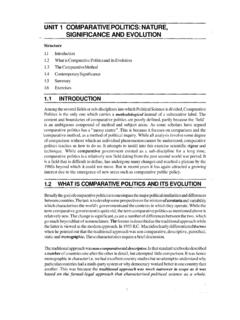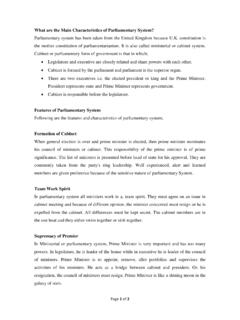Transcription of UNIT 4 LINEAR PROGRAMMING - SIMPLEX METHOD
1 PROGRAMMING Techniques LINEAR PROGRAMMING and Application UNIT 4 LINEAR PROGRAMMING - SIMPLEX METHOD Objectives After studying this unit, you should be able to : describe the principle of SIMPLEX METHOD discuss the SIMPLEX computation explain two phase and M- METHOD of computation work out the sensitivity analysis formulate the dual LINEAR PROGRAMMING problem and analyse the dual variables. Structure Introduction Principle of SIMPLEX METHOD Computational aspect of SIMPLEX METHOD SIMPLEX METHOD with several Decision Variables Two Phase and M- METHOD Multiple Solution.
2 Unbounded Solution and Infeasible Problem Sensitivity Analysis Dual LINEAR PROGRAMMING Problem Summary Key Words Self-assessment Exercises Answers Further Readings INTRODUCTION Although the graphical METHOD of solving LINEAR PROGRAMMING problem is an invaluable aid to understand its basic structure, the METHOD is of limited application in industrial problems as the number of variables occurring there is substantially large. A more general METHOD known as SIMPLEX METHOD is suitable for solving LINEAR PROGRAMMING problems with a larger number of variables.
3 The METHOD through an iterative process progressively approaches and ultimately reaches to the minimum value of the objective function. The METHOD also helps the decision maker to identify the redundant constraints, an unbounded solution, multiple solution and an infeasible problem. In industrial applications of LINEAR PROGRAMMING , the coefficients of the objective function and the right hand side of the constraints are seldom known with complete certainty. In many problems the uncertainty is so great that the effect of inaccurate coefficients can be predominant.
4 The effect of changes in the coefficients in the minimum value of the objective function can be studied through a technique known as Sensitivity Analysis. Every LINEAR PROGRAMMING problem has a dual problem associated with it. The solution of this problem is readily obtained from the solution of the original problem if SIMPLEX METHOD is used for this purpose. The variables of dual problem are known as dual variables or shadow price of the. various resources. The solution of the dual problem can be used by the decision maker for augmenting the resources.
5 The methodological aspects of the SIMPLEX METHOD is explained with a LINEAR PROGRAMMING problem with two decision variables in the next section. 30 LINEAR PROGRAMMING 31 SIMPLEX METHOD PRINCIPLE OF SIMPLEX METHOD We explain the principle of the SIMPLEX METHOD with the help of the two variable LINEAR PROGRAMMING problem introduced in Unit 3, Section 2. Example I Maximise 50x1 + 60x2 Solution We introduce variables x3 .>. 0, x4 0, x5 r 0 So that the constraints become equations The variables x3, x4, x5 are known as slack variables corresponding to the three constraints.
6 The system of equations has five variables (including the slack variables) and three equations. Basic Solution In the system of equations as presented above we may equate any two variables to zero. The system then consists of three equations with three variables. If this system of three equations with three variables is solvable such a solution is known as a basic solution. In the example considered above suppose we take x, = 0, x2 = O. The solution of the system with remaining three variables is x3 = 300, x4 = 509, x5 = 812. This is a basic solution of the system.
7 The variables x3, x4 and x5 are known as basic variables while the variables x1, x2 are known as non basic variables (variables which are equated to zero). Since there are three equations and five variables the two non basic variables can be chosen in 5c2, = 10 ways. Thus, the maximum number of basic solutions is 10, for in some cases the three variable three equation problem may not be solvable. In the general case, if the number of constraints of the LINEAR PROGRAMMING problem is m and the number of variables (including the slack variables) is n then there are at most basic solutions.
8 Basic Feasible Solution A basic solution of a LINEAR PROGRAMMING problem is a basic feasible solution if it is feasible, all the variables are non negative. The solution x3 = 300, x4 = 509, x5 = 812 is a basic feasible solution of the problem. Again, if the number of constraints is m and the number of variables (including the slack variables) is n, the maximum number of basic feasible' solution is The following result (Hadley, 1969) will help you to identify the extreme points of the convex set of feasible solutions analytically. Every basic feasible solution of the problem is an extreme point of the convex set of feasible solutions and every extreme point is a basic feasible solution of the set of Constraints.
9 When several variables are present in a LINEAR PROGRAMMING problem it is not possible to identify the extreme points geometrically. But we can identify them through the PROGRAMMING Techniques 32 LINEAR PROGRAMMING and Application ii) iii) iv) v) vi) vii)basic feasible solutions. Since one of the basic feasible solutions will maximise or minimise the objective function, we can carry out this search starting from one basic feasible solution to another. The SIMPLEX METHOD provides a systematic search so that the objective function increases (in the case of maximisation) progressively until the basic feasible solution has been identified where the objective function is maximised.
10 The computational aspect of the SIMPLEX METHOD is presented in the next section. Activity 1 Fill up the blanks : i) ..variables are introduced to make ..type inequalities equations. A system with m equations and n variables has at most ..basic solutions. A basic solution with m equations and n variables has .. variables equal to zero. A basic feasible solution is a basic solution whose variables are .. The maximum number of basic feasible solutions in a system with m equations and n variables is .. In a LINEAR PROGRAMMING problem every ..point of the Convex set of feasible solutions is a.










